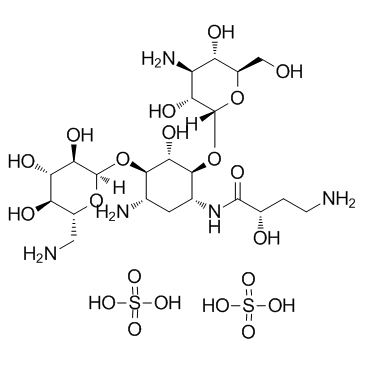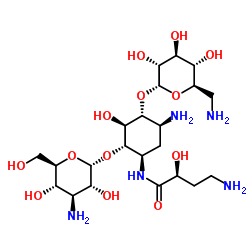39831-55-5
| 中文名 | 硫酸丁胺卡那霉素 |
|---|---|
| 英文名 | amikacin disulfate |
| 中文别名 |
硫酸阿米卡星
硫酸阿米卡星 O-3-氨基-3-脱氧-alpha-D-葡吡喃糖基-(1→6)-O-[(6-氨基-6-脱氧-alpha-D-葡吡喃糖基-(1→4)]-N-(4-氨基-2-羟基-1-氧丁基)-2-脱氧-D-链霉胺硫酸盐 地佐环平 |
| 英文别名 |
2-[(3-aminopropyl)amino]ethylphosphorothioic acid monohydrate
Amifostina Amifostinum Amikacin disulfate salt EINECS 254-648-6 D-Streptamine amikacin disulphate Amikacin Sulphate MFCD00167475 amifostine monohydrate Butanamide, 4-amino-N-[(1R,2S,3S,4R,5S)-5-amino-2-[(3-amino-3-deoxy-α-D-glucopyranosyl)oxy]-4-[(6-amino-6-deoxy-β-D-glucopyranosyl)oxy]-3-hydroxycyclohexyl]-2-hydroxy-, (2S)-, sulfate (1:2) (sa lt) Amifostine hydrate amikacin disulfate Butanamide, 4-amino-N-[(1R,2S,3S,4R,5S)-5-amino-2-[(3-amino-3-deoxy-α-D-glucopyranosyl)oxy]-4-[(6-amino-6-deoxy-α-D-glucopyranosyl)oxy]-3-hydroxycyclohexyl]-2-hydroxy-, (2S)-, sulfate (1:2) (s alt) (2S)-4-Amino-N-{(1R,2S,3S,4R,5S)-5-amino-2-[(3-amino-3-deoxy-α-D-glucopyranosyl)oxy]-4-[(6-amino-6-deoxy-β-D-glucopyranosyl)oxy]-3-hydroxycyclohexyl}-2-hydroxybutanamide sulfate (1:2) (2S)-4-Amino-N-{(1R,2S,3S,4R,5S)-5-amino-2-[(3-amino-3-deoxy-α-D-glucopyranosyl)oxy]-4-[(6-amino-6-deoxy-α-D-glucopyranosyl)oxy]-3-hydroxycyclohexyl}-2-hydroxybutanamide sulfate (1:2) Amikacin sulfate Amikacin (sulfate) |
| 描述 | Amikacin硫酸盐(BAY416651)是半合成氨基葡萄糖苷抗生素,卡那霉素A衍生物。 |
|---|---|
| 相关类别 | |
| 参考文献 |
[1]. Edson, R.S. and C.L. Terrell, The aminoglycosides. Mayo Clin Proc, 1999. 74(5): p. 519-28. |
| 沸点 | 981.8ºC at 760 mmHg |
|---|---|
| 熔点 | 220-230ºC |
| 分子式 | C22H47N5O21S2 |
| 分子量 | 781.760 |
| 精确质量 | 781.220520 |
| PSA | 497.90000 |
| 外观性状 | 固体 |
| 储存条件 | 密封、阴凉、干燥保存 |
| 稳定性 | 常规情况下不会分解,没有危险反应 |
| 水溶解性 | H2O: 50 mg/mL, clear, colorless |
| 更多 | 1. 性状:粉末 2. 密度(g/mL,25 ºC):未确定 3. 相对蒸汽密度(g/mL,空气=1): 未确定 4. 熔点(ºC):220-230 5. 沸点(ºC):未确定 6. 沸点(ºC,12mm hg):未确定 7. 折射率:未确定 8. 闪点(ºC):未确定 9. 比旋光度(º):未确定 10. 自燃点或引燃温度(ºC): 未确定 11. 蒸气压(kPa,25ºC):未确定 12. 饱和蒸气压(kPa,60ºC): 未确定 13. 燃烧热(KJ/mol):未确定 14. 临界温度(ºC):未确定 15. 临界压力(KPa):未确定 16. 油水(辛醇/水)分配系数的对数值:未确定 17. 爆炸上限(%,V/V):未确定 18. 爆炸下限(%,V/V):未确定 19. 溶解性:可溶解的 |
|
Section 1. Chemical Product and Company Identification Amikacin sulfateCatalog A1309, A1624, YY223 Common Name/ Number(s). Trade Name CAS#39831-55-5
Manufacturer RTECSWK1961200 SPECTRUM QUALITY PRODUCTS INC. TSCATSCA 8(b) inventory: No products were found. Commercial Name(s)Not available. CI# Not available. SynonymO-3-Amino-3-deoxy-alpha-D-glucopyranosyl-(1-6)-O-(6-amino-6-deoxy-alpha-D-glucopyranosyl-(1-4))-N(sup 1)-(4-amino-2-hydroxy-1-oxobutyl)-2-deoxy-(S)-D-streptamine sulfate IN CASE OF EMERGENCY (1:2) salt Chemical NameNot available. Not available.CALL (310) 516-8000 Chemical Family Chemical FormulaC22H43N5O13.2H2SO4 SPECTRUM QUALITY PRODUCTS INC. Section 2.Composition and Information on Ingredients Exposure Limits TWA (mg/m3)STEL (mg/m3) CEIL (mg/m3) NameCAS #% by Weight 1) Amikacin sulfate39831-55-5100 Toxicological DataAmikacin sulfate: on IngredientsORAL (LD50):Acute: 4001 mg/kg [Rat]. 10679 mg/kg [Mouse]. 3001 mg/kg [Rabbit]. Section 3. Hazards Identification Potential Acute Health Effects Hazardous in case of skin contact (irritant), of eye contact (irritant), of ingestion. Slightly hazardous in case of inhalation. Potential Chronic HealthCARCINOGENIC EFFECTS: Not available. MUTAGENIC EFFECTS: Not available. Effects TERATOGENIC EFFECTS: Not available. DEVELOPMENTAL TOXICITY: Not available. Repeated or prolonged exposure is not known to aggravate medical condition. Amikacin sulfate Section 4. First Aid Measures Eye ContactCheck for and remove any contact lenses. In case of contact, immediately flush eyes with plenty of water for at least 15 minutes. Cold water may be used. Get medical attention. Skin ContactIn case of contact, immediately flush skin with plenty of water. Cover the irritated skin with an emollient. Remove contaminated clothing and shoes. Cold water may be used.Wash clothing before reuse. Thoroughly clean shoes before reuse. Get medical attention. Serious Skin ContactWash with a disinfectant soap and cover the contaminated skin with an anti-bacterial cream. Seek medical attention. InhalationIf inhaled, remove to fresh air. If not breathing, give artificial respiration. If breathing is difficult, give oxygen. Get medical attention. Serious InhalationNot available. IngestionDo NOT induce vomiting unless directed to do so by medical personnel. Never give anything by mouth to an unconscious person. Loosen tight clothing such as a collar, tie, belt or waistband. Get medical attention if symptoms appear. Serious IngestionNot available. Section 5. Fire and Explosion Data Flammability of the Product May be combustible at high temperature. Auto-Ignition Temperature Not available. Flash PointsNot available. Flammable LimitsNot available. Products of CombustionThese products are carbon oxides (CO, CO2), nitrogen oxides (NO, NO2...), sulfur oxides (SO2, SO3...). Fire Hazards in Presence of Not available. Various Substances Explosion Hazards in Presence Risks of explosion of the product in presence of mechanical impact: Not available. of Various SubstancesRisks of explosion of the product in presence of static discharge: Not available. Fire Fighting MediaSMALL FIRE: Use DRY chemical powder. and InstructionsLARGE FIRE: Use water spray, fog or foam. Do not use water jet. Special Remarks onNot available. Fire Hazards Special Remarks on Explosion Not available. Hazards Section 6. Accidental Release Measures Small SpillUse appropriate tools to put the spilled solid in a convenient waste disposal container. If necessary: Neutralize the residue with a dilute solution of sodium carbonate. Finish cleaning by spreading water on the contaminated surface and dispose of according to local and regional authority requirements. Large SpillUse a shovel to put the material into a convenient waste disposal container. Neutralize the residue with a dilute solution of sodium carbonate. Finish cleaning by spreading water on the contaminated surface and allow to evacuate through the sanitary system. Amikacin sulfate Section 7. Handling and Storage PrecautionsKeep away from heat. Keep away from sources of ignition. Empty containers pose a fire risk, evaporate the residue under a fume hood. Ground all equipment containing material. Do not ingest. Do not breathe dust. Wear suitable protective clothing. If ingested, seek medical advice immediately and show the container or the label. Avoid contact with skin and eyes. StorageKeep container tightly closed. Keep container in a cool, well-ventilated area. Section 8. Exposure Controls/Personal Protection Engineering ControlsUse process enclosures, local exhaust ventilation, or other engineering controls to keep airborne levels below recommended exposure limits. If user operations generate dust, fume or mist, use ventilation to keep exposure to airborne contaminants below the exposure limit. Personal ProtectionSplash goggles. Lab coat. Dust respirator. Be sure to use an approved/certified respirator or equivalent. Gloves. Personal Protection in Case of Splash goggles. Full suit. Dust respirator. Boots. Gloves. A self contained breathing apparatus should be used a Large Spillto avoid inhalation of the product. Suggested protective clothing might not be sufficient; consult a specialist BEFORE handling this product. Exposure LimitsNot available. Section 9. Physical and Chemical Properties Physical state and appearance Solid.OdorNot available. Not available. Taste Molecular Weight781.77 g/mole Not available. Color 3 [Acidic.] pH (1% soln/water) Boiling PointNot available. Melting PointDecomposition temperature: 220°C (428°F) Critical TemperatureNot available. Specific GravityNot available. Not applicable. Vapor Pressure Vapor DensityNot available. Not available. Volatility Odor ThresholdNot available. Water/Oil Dist. Coeff.Not available. Ionicity (in Water)Not available. Dispersion PropertiesSee solubility in water. SolubilityPartially soluble in cold water. Section 10. Stability and Reactivity Data StabilityThe product is stable. Instability TemperatureNot available. Conditions of InstabilityNot available. Incompatibility with variousNot available. substances CorrosivityNot available. Amikacin sulfate Special Remarks onNot available. Reactivity Special Remarks onNot available. Corrosivity PolymerizationWill not occur. Section 11. Toxicological Information Routes of EntryEye contact. Ingestion. Toxicity to AnimalsAcute oral toxicity (LD50): 3001 mg/kg [Rabbit]. Chronic Effects on Humans Not available. Other Toxic Effects onHazardous in case of skin contact (irritant), of ingestion. HumansSlightly hazardous in case of inhalation. Special Remarks onNot available. Toxicity to Animals Special Remarks onNot available. Chronic Effects on Humans Special Remarks on otherNot available. Toxic Effects on Humans Section 12. Ecological Information Not available. Ecotoxicity BOD5 and CODNot available. Products of BiodegradationPossibly hazardous short term degradation products are not likely. However, long term degradation products may arise. Toxicity of the ProductsThe products of degradation are more toxic. of Biodegradation Special Remarks on theNot available. Products of Biodegradation Section 13. Disposal Considerations Waste Disposal Section 14. Transport Information DOT ClassificationNot a DOT controlled material (United States). IdentificationNot applicable. Not applicable. Special Provisions for Transport DOT (Pictograms) Amikacin sulfate Section 15. Other Regulatory Information and Pictograms California prop. 65: This product contains the following ingredients for which the State of California has found to Federal and State cause cancer, birth defects or other reproductive harm, which would require a warning under the statute: Regulations Amikacin sulfate California prop. 65: This product contains the following ingredients for which the State of California has found to cause birth defects which would require a warning under the statute: Amikacin sulfate California California prop. 65: This product contains the following ingredients for which the State of California has found Proposition 65 to cause birth defects which would require a warning under the statute: Amikacin sulfate Warnings Other RegulationsNot available. WHMIS (Canada) Not controlled under WHMIS (Canada). Other Classifications DSCL (EEC)R36/38- Irritating to eyes and skin. Health Hazard HMIS (U.S.A.)2 National Fire Protection 1 Flammability 1 Association (U.S.A.) Fire Hazard 2 0 Reactivity Health Reactivity 0 Specific hazard Personal Protection E WHMIS (Canada) (Pictograms) DSCL (Europe) (Pictograms) TDG (Canada) (Pictograms) ADR (Europe) (Pictograms) Protective Equipment Gloves. Lab coat. Dust respirator. Be sure to use an approved/certified respirator or equivalent. Splash goggles. SECTION 16 - ADDITIONAL INFORMATION N/A |
|
生态学数据: 对水是稍微有危害的不要让未稀释或大量的产品接触地下水、水道或者污水系统,若无政府许可,勿将材料排入周围环境。 CHEMICAL IDENTIFICATION
HEALTH HAZARD DATAACUTE TOXICITY DATA
|
| 个人防护装备 | Eyeshields;Gloves;type N95 (US);type P1 (EN143) respirator filter |
|---|---|
| 危害码 (欧洲) | Xi |
| 风险声明 (欧洲) | R36/37/38 |
| 安全声明 (欧洲) | 26-36 |
| 危险品运输编码 | NONH for all modes of transport |
| WGK德国 | 2 |
| RTECS号 | WK1961200 |
| 海关编码 | 29419000 |
| 上游产品 0 | |
|---|---|
| 下游产品 1 | |



